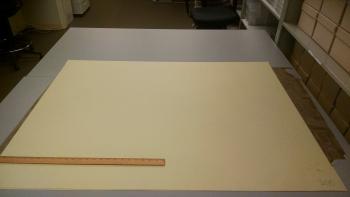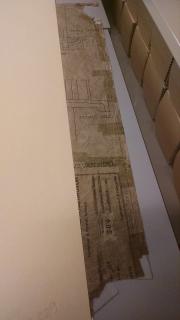This past summer, I had the opportunity to work on an inventory and rehousing project for the oversized map cases at the archives. I inherited this project from a previous intern Caitria Sunderland, who had already rehoused and completed the inventory for drawers 13-77. I started my portion the inventory my first week on drawer 78 out of 252. I finished the inventory and then started working on the rehousing project.
While the name “map case” suggests that the collections in these drawers are homogenous, they are not at all. Each drawer held new surprises and challenges. Some drawers had a lot of material, others only had a few very thick items. Some contained only posters for art museums or plans for different museums, others had star charts and maps for the migrations of birds. This amount of variety helped me learn more about working with a wider range of oversized material. Once the inventory was finished, the next question was how to rearrange the collections to maximize the number of items that would fit in the drawers. The conclusion was made to arrange the collections by size, largest first. This fit our needs best because it would increase the number of smaller folders that could fit in a drawer. For example, while only one 36 x 48 inch folder would fit in a standard size drawer, two 24 x 36 inch folders would fit side by side, doubling the number of folders that could fit in a drawer. Rehousing also helps in this situation. Rehousing is most important because it makes sure that the folder is large enough to protect the object and small enough to fit more in a drawer and make the folder easily handled. This plan below was originally in a 24 x 36 inch folder, but a 16 x 20 inch folder was a better fit-- and meant that it was moved into a small drawing box, instead of being in a map case, saving more space.


 For the rehousing portion of the project, I started with drawer 001. Drawers 001-012 are special, as they are larger than the normal oversize map cases at 57 x 87 inches. When I was working with the smaller drawers, each folder could contain up to 50 or 60 architectural plans. With the larger drawers, each folder only had one plan, meaning that I got more up-close and personal with each individual item, like the plans for the National Museum of Natural History.
For the rehousing portion of the project, I started with drawer 001. Drawers 001-012 are special, as they are larger than the normal oversize map cases at 57 x 87 inches. When I was working with the smaller drawers, each folder could contain up to 50 or 60 architectural plans. With the larger drawers, each folder only had one plan, meaning that I got more up-close and personal with each individual item, like the plans for the National Museum of Natural History.
The plans were consolidated so that there were 10 plans in each folder, instead of only one. This decreased the amount of space folder stock was taking up in the drawer, and once they were rehoused in larger folders the plans were not being damaged. These plans were originally housed in 36 x 48 inch folders, which were too small, and were then moved to 40 x 56 inch folders. These larger folders ensured that no part of the plan would stick out if the plans were properly oriented.
Once the plans were snug in their brand-new folders, they were put back into the drawers. This time they were place side by side with a custom divider in between. Drawers 001-012 were finished, and then I began the work on drawers 013-252, with multiple sizes of folders.
With the end of my internship approaching fast, I only was able to get to drawer 56 in the rehousing project before I had to go back to college. Between the amazing collections and the wonderful staff at the Archives, I had a rewarding summer working in the map cases!
Related Resources
An ‘Intern’duction to Storage of Oversized Archival Collections, The Bigger Picture, Smithsonian Institution Archives
The Squeaky Wheel Gets the Grease: A Custom Storage Solution for an Unusual Collection, The Bigger Picture, Smithsonian Institution Archives
Produced by the Smithsonian Institution Archives. For copyright questions, please see the Terms of Use.

Leave a Comment